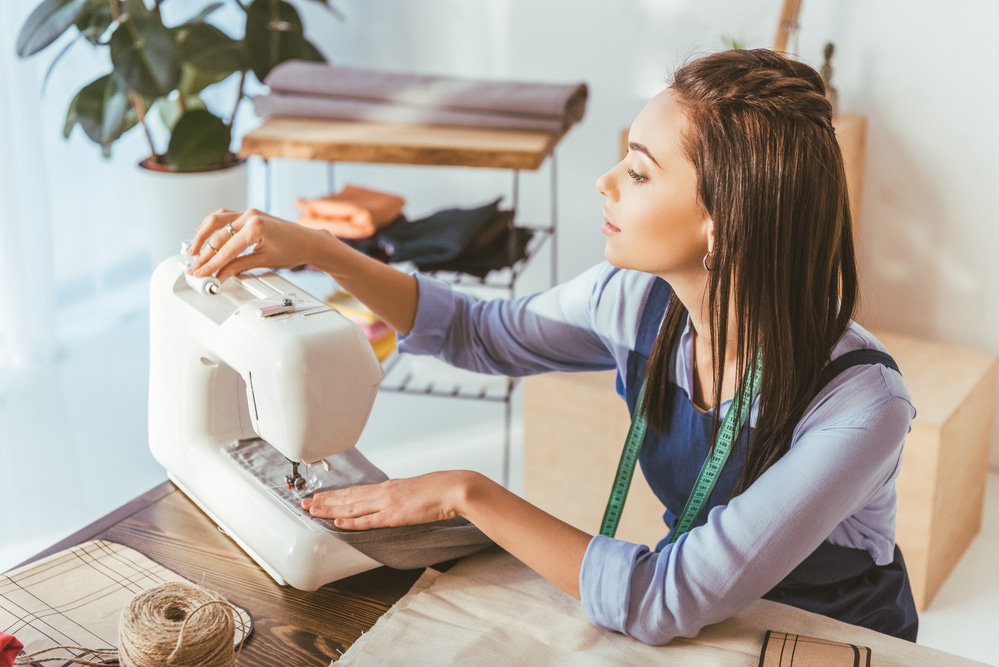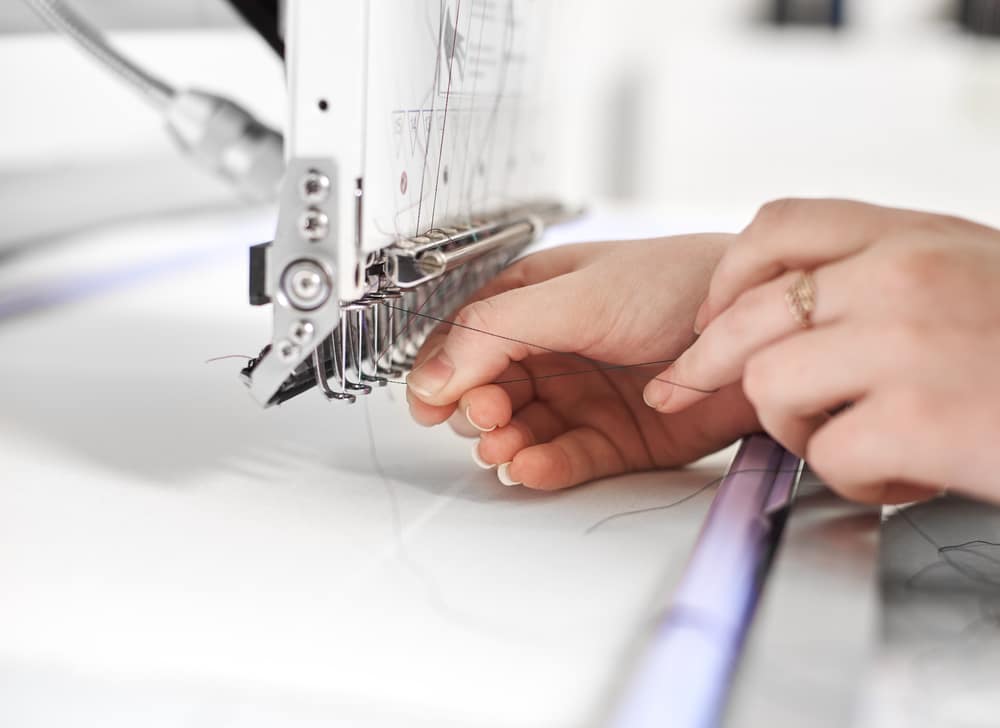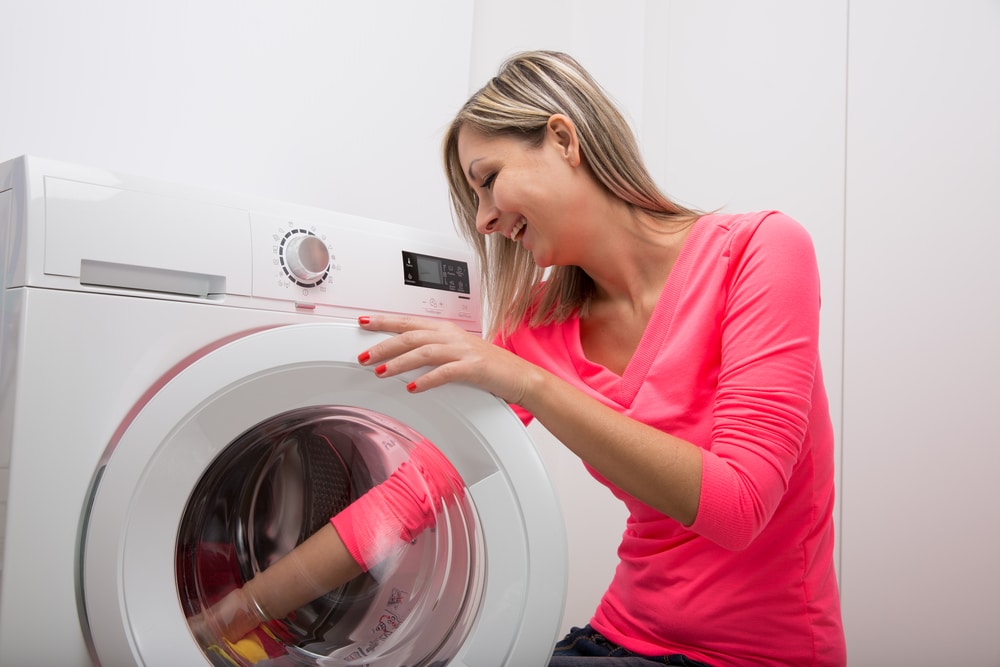Last Updated on
Most sewing machines operate the same, but there are some differences between these machines. It is crucial to be aware of the type you are using so you can understand how to use it. So, how does a sewing machine work? In today’s article, we will uncover this information by looking at the unique mechanisms that make them up.
Let’s Get Started
Knowing the type of thread can help you when threading a sewing machine. There are many functional movements and thought behind a sewing machine, so here are some ways that these machines function.
Needle Thread
The sewing machine’s needle mechanism is the simplest operation process for a sewing machine. It works by the grey shaft driving a wheel and crankshaft to control the needle motion. As a result, the needle can rise and lower while the crank allows the needle plate to move round and round.
Bobbin Thread
Next, the bobbin winder makes stitches from the needle thread rotate faster than the needle. Therefore, the shaft turns quickly using gears to increase its speed. This thread is also sometimes referred to as the lower thread. The lower thread moves through the upper thread to hold it in place.
Feed Dog
Feed dogs are thin bars located in a metal plate that help to hold and guide your fabric. The feed dog mechanism moves the fabric at a constant speed through the sewing machine, resulting in stitches that are all equal in length. The feed dogs work by moving up and forwards simultaneously. All the while, a second mechanism moves the feed dogs up and down, and when these two movements happen, the feed dog walks the material through the sewing machine with a single stitch at a time.
Tension Regulator
You need a part of a sewing machine that controls the top thread’s tension to bring the top thread and bobbin thread together. Depending on the type of sewing machine you have, there will either be a manual dial that you’ll have to operate to increase or decrease the tension, or you’ll be able to adjust the tension on a digital display.
Take-Up Lever
The upper thread passes up through the lever, creating an up and down movement within the needle. However, before you add the fabric under the foot, you’ll need to raise the lever to prevent the fabric from tearing against the needle.
How Do Sewing Machines Stitch?
This is a valid question. Sewing machines are amazing devices that free us from the need to sew and enable us to create new clothing as well as mend holes and other damages.
In a nutshell, the combination of internal mechanisms within a sewing machine works to create evenly spaced stitches. This happens by the upper thread feeding on the spool and poking through the eye of the needle.
At the same time, the bottom thread feeds the thread from the bobbin. As a result, the needle bar moves up and down, piercing the fabric with this action. To stop the thread from pulling off, the top thread needs to have just the right amount of tension.
After the needle punctures the material, the bottom thread holds onto the bobbin case and rotates. The bobbin cover then enables the hook to pass through the loop created by the top thread.
Then, the needle rises, and the shuttle hook hooks the thread around the bobbin thread. Once the needle pulls upwards, it tightens and pulls it back. This process continually repeats (when you press on the foot pedal) to create a straight stitch.
The Different Types of Sewing Machines
Even though how the sewing machine was invented is fairly universal, there are some differences in how different sewing machines function.
Mechanical Machines
Mechanical sewing machines are the most standard type of machine and are usually hand-operated. Designed before electricity was accessible to everyone, this type of sewing machine is easy to use.
Without an electric motor, you operate this traditional sewing machine using a handwheel or a handle to move the needle to make the stitches. Mechanical machines were typically heavier than modern appliances since they were designed of metal and built to be durable while also remaining stable on a surface during use. Additionally, this sewing machine could only perform a straight line and was quite limited in its results.
Electronic Machines

Electronic sewing machines, on the contrary, have a lot more sewing options and more benefits to them than a practical sewing machine. In particular, they provide a wider range of stitches along with various lengths to offer. In fact, you can create decorative patterns, zigzags and more with electronic sewing machines. They have an electric motor and a presser foot to operate.
Portable Machines
Since some people want to sew on the go or in different locations, the portable sewing machine was invented. This type of sewing machine is lightweight and compact, enabling you to transport it wherever you go conveniently. However, this compact design means that it’s only suitable for smaller projects and the odd occasion instead of sewing an entirely new dress.
Quilting Machines
This type of sewing machine is, as the name suggests, best for sewing large quilts and thick fabric. This sewing machine features a long arm to enable a great volume of fabric to come through, allowing you to sew thick layers of fabric at once. The sewing machine’s feed ensures excellent stead stitches while keeping the fabric in place to prevent mistakes.
Automated Machine
An automated sewing machine comes equipped with an LED screen, embroidery stitches and automatic needle threading. The chances are that this type of sewing machine will also offer different stitch lengths and feature various tension controls.
Additionally, this type of sewing machine will feature built-in stitch programs to make the task easier, and while this appliance can be expensive, it’s sturdy and durable.
Embroidery Machines
An embroidery sewing machine is a high-tech option featuring a USB port that allows you to access various designs and import them into the sewing machine’s memory. As a result, this type of sewing machine is typically expensive and can even cost you thousands of pounds. However, it’s an ideal option for professionals or those seeking assistance with sewing.
Top Tips for Using a Sewing Machine
Now you know how a sewing machine works, it’s time to get down to business. Now, you can do so many things, from customizing bath towels to hemming your trousers. However, that involves reading these useful tips on operating a sewing machine to enhance your stitching skills.
Prepare Your Fabric
Sewing machines can work wonders, but they’re not magical. This means that you’re responsible for arranging and preparing the fabric for the best results. In particular, ensure that the fabric is smooth against the surface for the best results. You may even want to iron the fabric beforehand if you require some assistance with flattening it.
Use the Same Colour Thread
One of the easiest ways to spot a sewing mishap is by using a different colour thread to the fabric that you’re sewing. Therefore, we recommend that you try to perfectly match your thread with the fabric before you begin any stitching. However, you’ll need to keep track of your thread loops when the thread loops begin to run out.
Make Smooth Curves
It’s easier said than done, but if you need to use a curve with your sewing machine, you’ll need to do so with a steady, controlled movement. You’ll also need to keep this movement fluid and in one go without any pauses, so ensure that your wrists are prepared for the curve to follow.
Keep your hands and fingers flexible to ensure a neat, steady curve while you pivot the fabric. If you’re nervous about this concept, you might want to practice smooth sewing curves on a spare piece of fabric, to begin with.
Keep Hold Of the Thread’s Tail at the Start of Sewing
When you begin sewing, you’ll want to keep hold of the thread’s tail before you even begin to make the first stitch. Otherwise, the thread could become tangled in the sewing machine and pull some fabric from thin materials. Fortunately, holding the threads’ tail will help to prevent this from happening as you begin sewing.
Keep Leftover Fabric for Practising
Practising your sewing technique will help you to become the best you can be. But you can only practise if you have the fabric to do so. This is why we suggest keeping any scraps of fabric from projects to practise with. Start sewing when you have some spare time to keep up with your sewing machine basics.
Check Your Bobbin
You don’t want to make the mistake of running out of thread mid-way through sewing, which is why we recommend checking the state of your bobbin before you get started. Otherwise, you could encounter an issue when you suddenly run out of thread halfway through sewing a piece of fabric. Avoid this from happening by getting into good habits from the start.
Take It Slow
Sewing isn’t a race so take the movements slow. Otherwise, you’re more susceptible to making mistakes that you can’t then amend. Take your time to read the instruction manual, identify the separate threads, the reverse lever, and the spool pin, as well as all of the other elements you need to know before you can thread the needle and get started. Familiarise yourself with your machine so that you can easily troubleshoot if something goes wrong.
Start Your Sewing Projects Today
Sewing is an art form and will take skill and practice to perfect, so it’s important to know how your sewing machine works to get the best results. Understanding the difference between a needle plate and a bobbin winder is vital in creating your masterpieces.
Are you thinking of starting sewing or already have some experience under your belt? Let us know any tips you have for using modern sewing machines. Or let us know some advice you have on sourcing your first sewing machine.
Amy is a U.K.-based writer and editor with a penchant for helping consumers find the best home products for their needs, as well as providing easily digestible guides for living better at home. Her dedication to her work means she can usually be found elbow-deep in research or hunting down samples of the latest and greatest on behalf of her readers.
An avid DIYer herself, Amy’s passion lies in teaching others how they too can achieve their dream homes by tackling some of those pesky projects themselves! Whether it’s building furniture from scratch or turning an old dresser into a coffee table, Amy is always happy to share what she knows about making your house feel like home without spending a fortune.



